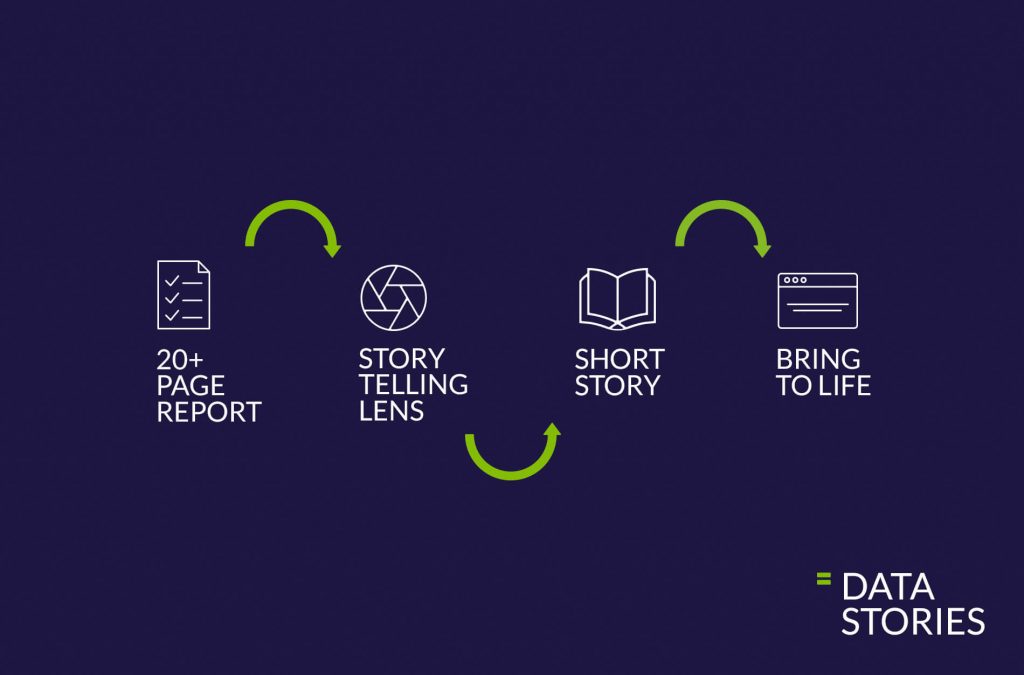We all love a good story. A narrative that draws us in, intrigues us and builds to a satisfying conclusion. Stories have the power to capture our attention and imagination and transform our thinking, almost without our realising that it’s happening. They cut through the confusion and stay with us, improving our ability to retain intrinsic messaging. In short, they help us to make sense of the world.
There are reasons for this. Straight facts affect the language-processing and comprehension parts of the brain. But when we hear a gripping tale, our grey matter lights up like a Christmas tree and neural activity increases fivefold, pulling in our emotion- and image-processing centres, too.
Despite the fact that we know all this, so much communication, especially in the business world, is still delivered in a dry, inaccessible format. And let’s face it, few people jump for joy at the prospect of wading through dense documentation, no matter how prescient they believe the content will be.
Every day we’re bombarded with information via email, text message, LinkedIn, Twitter. So what is the best way to cut through and ensure that your message is received, understood and, most importantly, acted upon?
The key is to focus on delivery as well as content. So often, the passion and creativity that is invested in research and discovery don’t make it onto the final page. There’s no hook, build and pay-off. Scant attention is paid to scene-setting and context, to holding the reader’s attention.
Team messaging hub Slack is a good example of a service that is getting it right. It should be a dry internal business communication tool, but in fact, it speaks to users in a very human voice. It takes visual and user-interface cues from the apps with which we’re all familiar and explains everything in an accessible, story-like way.
Mind your language
When we began working with professional services network Deloitte, it was in a frustrating position. It was producing in-depth reports for c-suite executives all over the world, outlining what businesses needed to do to remain strong and resilient in a rapidly changing global economy. It was providing data and information that had the ability to change the plight of individuals and businesses alike, addressing common concerns and giving the answers to burning questions. But Deloitte knew it could go further with its research, reach more of the right people.
The problem? The resource was written in a format that many found difficult to access and decipher. The solution? We looked at it through a storytelling lens and created a universal language that more people could engage with and enjoy. Our role was to decode and translate, and then provide the mechanisms by which readers could find their way to the information that was relevant to them.
We must never lose sight of the fact that businessmen and women are just regular people. They like to watch the latest movies and boxsets just like everyone else, so to communicate in a rarefied, cliquish way makes no sense. By taking a more accessible approach, you’ll increase the chance that your target audience will grasp the message and act upon it. All that hard work and research is less likely to go to waste, and people will come back for more.
Increase the reach
Long-form reports will always have their place. Research shows that they have a gravitas and depth that is appreciated by execs looking for detailed, contemporary data to inform their key decisions. But we also know that these execs are now consuming news and information across myriad platforms, and that some of the more traditional delivery formats are turning them off. In this day and age, information needs to work across all devices. Who wants to scroll through reams of PDFs on a smart phone, after all? Deloitte’s clients need its thoroughly researched insights, but they want them in a way that they can access and comprehend quickly and easily, wherever they are.
Rather than create a summary – a kind of Brodie’s Notes – our approach was to pick out key themes and work them up into striking concepts and metaphors. By using the power of storytelling and data visualisation, by breaking away from tired, narrow business techniques, we found that the target readers were much more likely to absorb and remember the report, and be able to tell it apart from competitors’ offerings.

The human touch
For Deloitte’s recent Power Up write-up, for example, which looks at what the UK economy can do, post-Brexit, to cope with a potential loss of 36% of its non-British workforce, we used engaging and beautifully illustrated and animated stories to help people visualise the problems and solutions outlined in the long-form report. Working alongside the full version, this approach made it easier for subscribers to steer through the data, dipping in and out where and when they chose to do so.
Eye-catching graphics and illustrations led the reader along a natural story arc, lifting the information off the page, making it tangible and bringing home the key message in an organic, memorable way.
Ultimately, this approach had a simple aim: it was about improving the relationship between recipient and research – people and things – and finding the most appropriate way to do this. In this instance, distilling complex data and communicating it in an appealing and arresting way really worked.
Time is tight for everyone. By taking a more human-centric approach, you can stand out from the crowd, engage with a wider audience and make a much bigger impact. True story.
Paul Ferry is Co-founder and Director of ShopTalk, a design studio that works with brand identity, communication and digital media.









